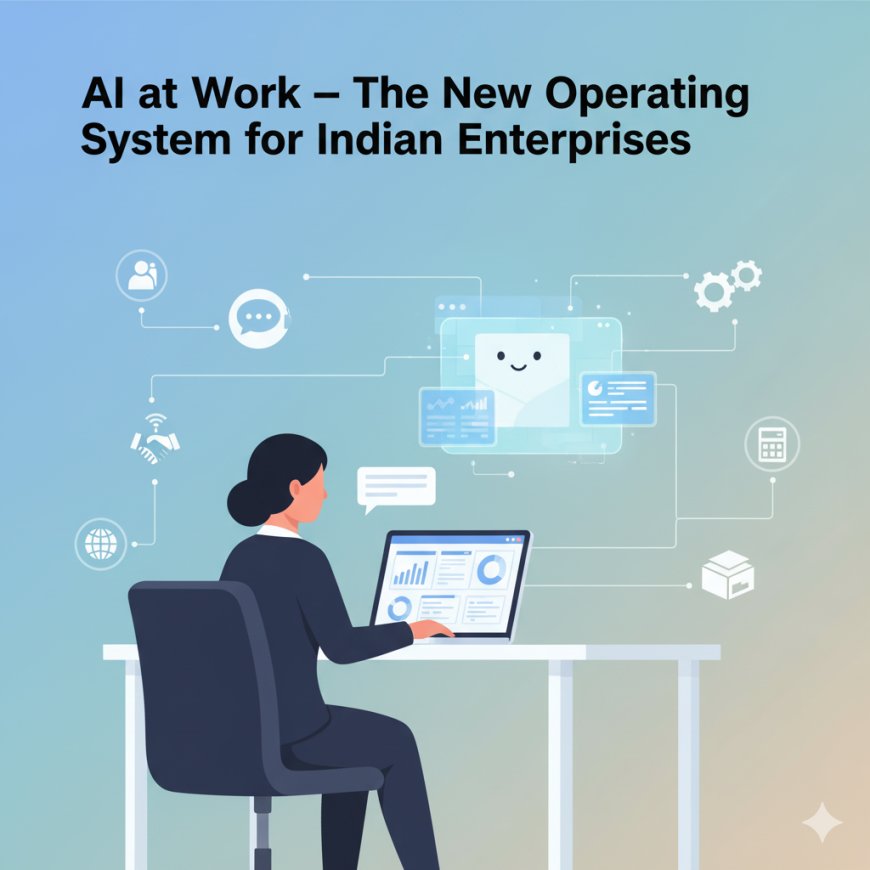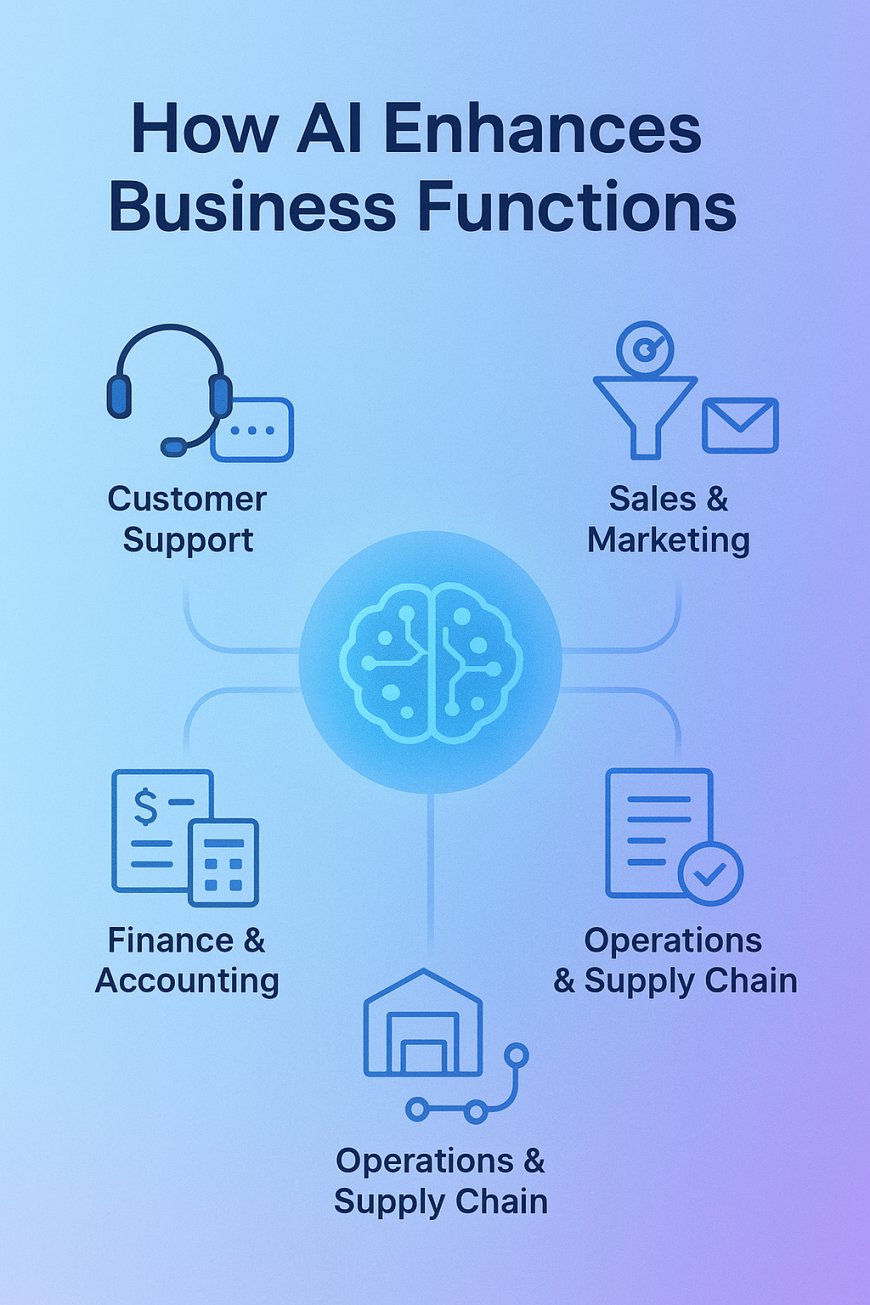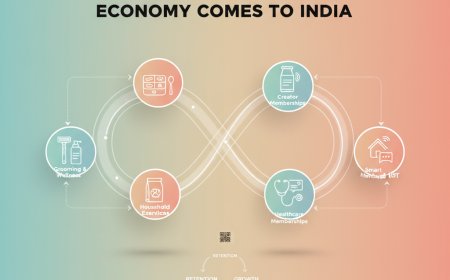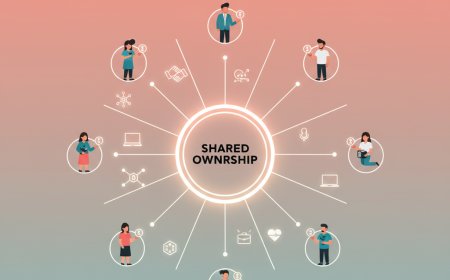Indian Enterprises Are Entering Their AI-Powered Era
Indian enterprises are rapidly integrating AI and automation to streamline workflows, improve customer experience, and boost productivity. This article explains how Indian MSMEs and large companies are adopting AI, where it’s being applied, real case examples, challenges, and what the future of AI-native operations looks like.

Over the past decade, Indian businesses have gone through a major transformation.
We started with manual-heavy operations — where everything depended on people, paperwork, and physical coordination. Then came the phase of digital adoption — CRMs, ERPs, online payments, and cloud tools became the norm.
Now, we’re entering the next stage: AI-driven execution.
This shift is happening for a few clear reasons:
- Productivity pressure is real. Businesses need to do more with less.
- Competition is increasing. From global brands to agile startups.
- AI tools are now affordable and accessible. You don’t need a big data team to benefit.
Today, companies aren’t just using software to support their work.
They are using AI to perform work — faster, cheaper, and more reliably.
But here’s the key point:
AI is not here to replace workers.
Instead, it is changing what their work looks like.
It takes over the repetitive, routine tasks — so people can focus on strategy, creativity, relationship-building, and decision-making.
The future is not humans vs. AI — it’s humans working with AI
What Does AI + Automation Integration Mean? (Simple Explanation)
When we talk about AI and automation in Indian enterprises, we’re not talking about installing a fancy chatbot and calling it “transformation.”
It means embedding intelligence into the daily workflows that keep a business running.
Imagine it like this:
|
Before AI |
After AI |
|
Employees manually process tasks |
Routine tasks happen automatically |
|
Managers make decisions based on gut feeling |
AI provides real-time insights |
|
Customer service answers queries one-by-one |
AI smartly handles 60-80% queries instantly |
Here’s what changes inside an organization:
- Repetitive processes (like data entry, invoice matching, scheduling) → get automated.
- Decisions (like forecasting, risk scoring, prioritizing leads) → become AI-assisted instead of guess-based.
- Customer interactions (like support, recommendations, personalization) → feel instant and tailored.
The main goal:
1.Work becomes faster
2.Work becomes smarter
3.Work becomes scalable without needing to hire endlessly
AI isn’t just a tool you use.
It becomes a silent teammate — running tasks in the background.
Why Indian Enterprises Are Adopting AI Now
This shift toward AI in Indian businesses isn’t happening by accident — the timing is right.
First, Indian companies now have access to global AI models from OpenAI, Anthropic, Google, Meta, and others. Anyone — from a startup to a large enterprise — can plug into these models via APIs without building everything from scratch.
Second, cloud infrastructure has become far more affordable. A decade ago, only big tech firms could run large-scale AI systems. Today, AWS, Google Cloud, and Azure hosting is cost-effective — and widely available in India.
Third, India has something most countries don’t: a digital public infrastructure that’s already in place.
Think about it:
- UPI → Digital payments everywhere
- Aadhaar → Verified digital identity
- GST Data → Business profiling and compliance history
- ONDC → Open e-commerce delivery rails
This creates a massive data foundation that AI can plug into and generate real value.
There’s also the push factor: business pressure.
Operating costs are rising. Competition is intense. Skilled workforce expectations are changing. To stay efficient, companies must automate the repetitive and optimize the workflows.
Add to this government support for automation, digitization, and AI skilling — and the result is clear:
It’s not just possible to integrate AI now — it’s necessary.
Where AI is Being Applied (Key Functional Areas)
AI is no longer a “future trend.”
It’s already working behind the scenes in core business functions across Indian companies.

Let’s break down where it’s showing real impact:
|
Function |
How AI/Automation Helps |
Real-World Examples |
|
Customer Support |
AI chatbots, voice bots, automated ticket routing reduce response time and free up human agents for complex cases. |
HDFC Bank’s AI chat assistant, Swiggy’s auto-resolution flows. |
|
Sales & Marketing |
AI scores leads, predicts purchase likelihood, creates personalized messaging, and automates follow-ups. |
CRM + AI integrations used widely in SaaS, retail, D2C, real estate. |
|
HR & Recruitment |
Resume scanning, skill-matching, candidate screening, onboarding workflows — all automated. |
Naukri AI tools, TurboHire offering AI-enabled assessment and screening. |
|
Finance & Accounting |
AI handles invoice matching, reconciliation, fraud risk scoring, and process approvals. |
Tally Prime automation extensions, Razorpay’s AI-powered payment risk engine. |
|
Operations & Supply Chain |
AI forecasts demand, manages warehouse inventory, plans logistics routes, and automates workflows using RPA bots. |
Used in manufacturing clusters, retail chains, logistics networks. |
In simple terms:
- Customer teams get faster.
- Sales teams get smarter.
- HR teams get efficient.
- Finance stays more accurate.
- Supply chains avoid mistakes before they happen.
AI is becoming the “invisible engine” behind daily business execution.
How MSMEs vs. Large Enterprises Are Adopting AI
AI adoption looks very different depending on the size and maturity of the business.
MSMEs (Micro, Small & Medium Enterprises)
For MSMEs, the priority is cost efficiency and workflow simplification. Their adoption is practical and problem-first, not innovation-first.
They are focusing on low-cost, high-impact automation, such as:
· WhatsApp Commerce & Chatbots → Automating customer queries, sales follow-ups, delivery updates.
· CRM Bots → Automatic lead reminders, pipeline tracking, customer tagging.
· Invoice & Billing AI → Automated invoice scanning, payment reminders, GST reconciliation.
Goal: Remove manual effort.
MSMEs don’t want futuristic AI labs — they want systems that save time today.
For MSMEs, AI is becoming the new “digital staff member” — always working, never tired.
Large Enterprises
Large companies are taking a systems-level approach to AI.
They are implementing:
· Advanced Predictive Analytics → Forecasting sales, churn, demand, and market trends.
· AI-Led Supply Chain Optimization → Warehouse routing, logistics networks, vendor management.
· Autonomous Workflows → End-to-end automation using RPA + AI + legacy ERP integrations.
Goal: Scale decisions, reduce inefficiencies, maximize ROI.
For large enterprises, AI is not about saving time — it’s about compounding efficiency gains at scale.
Summary:
· MSMEs use AI to reduce manual workload.
· Large Enterprises use AI to enhance competitive advantage.
The Benefits (What Changes When AI is Integrated)
When AI becomes part of daily workflows, the impact is visible almost immediately — not just on speed, but on how teams work and decide.

1. Faster Workflows, Lower Overheads
Processes that took hours (or days) — approvals, reconciliation, support replies, analytics — are now completed in seconds.
This reduces operational load and allows businesses to handle more work with the same resources.
2. Significant Reduction in Human Error
Data entry, classification, financial matching, ticket routing — these tasks are prone to mistakes when done manually.
AI standardizes them, ensuring accuracy and consistency.
3. Better Customer Experience
AI personalizes:
· Product recommendations
· Service responses
· Follow-up interactions
Customers feel understood — and conversion + retention improves.
4. Teams Shift From Repetitive Tasks → Strategic Work
Employees stop spending time on:
· Copy-paste admin tasks
· Report compilation
· Data entry and coordination
They shift to:
· Customer relationship building
· Problem-solving
· Growth strategy
This increases employee morale and business creativity.
5. Data Becomes a Competitive Advantage
Once workflows are automated and digital:
· Data becomes unified
· Patterns become visible
· Decisions become proactive, not reactive
Businesses start predicting, not just reacting to the market.
AI doesn’t just make work faster. It changes how work is done.
Teams evolve. Decisions improve. The business becomes smarter.
Real-World Case Examples (India Context)
AI adoption in India isn’t theoretical — it’s already visible across sectors.
Here are real examples showing how automation is reshaping operations:
Zetwerk: Coordinating Complex Manufacturing with AI
Zetwerk manages hundreds of suppliers, manufacturers, and delivery timelines.
Without automation, this would require massive manual coordination.
They use AI to:
· Predict supplier delays before they happen
· Optimize production workflows
· Match orders with the best-fit factories based on capacity & delivery timelines
This reduces manufacturing lead times and improves consistency — even at scale.
Zetwerk proves that AI isn’t only for tech companies — it powers heavy industry too.
Reliance Retail: AI-Driven Hyperlocal Inventory & Pricing
Reliance handles millions of SKUs across retail stores, online delivery platforms, and warehouses.
Tiny changes in demand create huge ripple effects.
They use AI to:
· Forecast demand at a store-by-store level
· Dynamically adjust inventory distribution
· Optimize pricing based on real-time local demand
This enables faster restocking, lower waste, and higher customer availability.
AI has turned Reliance Retail’s supply chain into a data-driven prediction engine.
The UPI Ecosystem: Automation at National Scale
UPI is the world’s best example of automated financial workflows.
No forms. No approvals. No intermediaries.
AI + Automation power:
· Fraud detection
· Transaction routing
· Real-time verification
· Bank settlement workflows
And all of this runs at population scale — serving both metro & rural users.
UPI shows how automation can make complex systems simple, accessible, and universal.
Challenges & Barriers
AI adoption is accelerating — but not without friction.
These challenges are real, but they are solvable.
1. Skill Gaps in AI Literacy
Many teams understand tools but not data-driven thinking.
This leads to underuse of AI systems that are already available.
Solution:
Upskill teams with practical, role-based AI training — not theoretical workshops.
2. Dependence on External AI Models
Most Indian companies rely on global AI providers (OpenAI, Google, etc.).
This raises concerns about:
· Data sovereignty
· Pricing dependence
· Long-term control
Solution:
India is already building local AI ecosystems — LLMs optimized for Indian languages & business workflows.
3. Resistance to Workflow Change
Teams often fear AI will “replace” them, leading to pushback.
Reality:
AI shifts roles — it doesn’t eliminate them.
People move from manual execution → oversight, analysis, and decision work.
Solution:
Position AI as a digital assistant, not a replacement.
4. Data Privacy & Compliance Complexities
Especially in:
· Healthcare
· Finance
· Government services
AI requires clear data handling frameworks.
Solution:
Adopt zero-trust architecture, strict access controls, and data minimization practices.
None of these challenges are permanent blockers.
With training, governance, and phased rollout, AI becomes not just adoptable — but transformative.
AI as a Team Member
The next stage of AI adoption in India is not about adding “tools.”
It’s about changing how teams work.
AI is becoming a co-worker — not just software in the background.
AI Copilots Will Assist Employees Across Roles
Employees won’t start from a blank screen anymore.
· Sales teams → get AI-written proposals, follow-up messages, and lead prioritization.
· Customer support → gets suggested replies based on conversation history.
· HR → gets auto-matched candidates + role fit assessments.
· Finance teams → get automated compliance checks & reconciliation suggestions.
Work becomes faster, guided, and less repetitive.
Autonomous Agents Will Run Mini Workflows End-to-End
We’ll soon see AI systems that don’t just assist — they execute.
For example:
· A customer asks a question
→ AI finds the answer
→ checks internal systems
→ updates a record
→ sends status back
→ and logs the interaction.
No human needed for routine loops.
This is process automation with decision-making, not just scripting.
AI Governance Will Become a Business Priority
As AI becomes part of core operations, trust matters.
Companies will need:
· Clear data usage rules
· Ethical guardrails
· Human override policies
· Audit trails for decisions made by AI systems
This ensures AI is safe, consistent, and aligned with business values.
The Shift Has Already Begun
Indian enterprises are moving from:
|
Yesterday |
Today |
|
“Let’s try AI” |
“Let’s embed AI in workflows” |
|
Standalone pilots |
End-to-end process redesign |
|
Tool usage |
AI-assisted execution |
|
Human-only teams |
Human + AI hybrid teams |
This is how Indian businesses become AI-native, not just AI-enabled.
Conclusion
AI and automation are not just a technology upgrade.
They represent a fundamental shift in how organizations operate.
The winning companies will be those that:
· Use AI to remove repetitive work
· Empower teams to focus on high-value problem-solving
· Build workflows where humans make decisions and AI handles execution
This is not about replacing people — it’s about amplifying capability.
As global competition accelerates, Indian businesses that adopt human + AI collaboration early will:
· Move faster
· Innovate more consistently
· Operate more efficiently
· And deliver better customer experience at scale
The future of Indian enterprise belongs to those who treat AI not as a tool — but as a teammate.
What's Your Reaction?
 Like
0
Like
0
 Dislike
0
Dislike
0
 Love
0
Love
0
 Funny
0
Funny
0
 Angry
0
Angry
0
 Sad
0
Sad
0
 Wow
0
Wow
0


























































































































































































